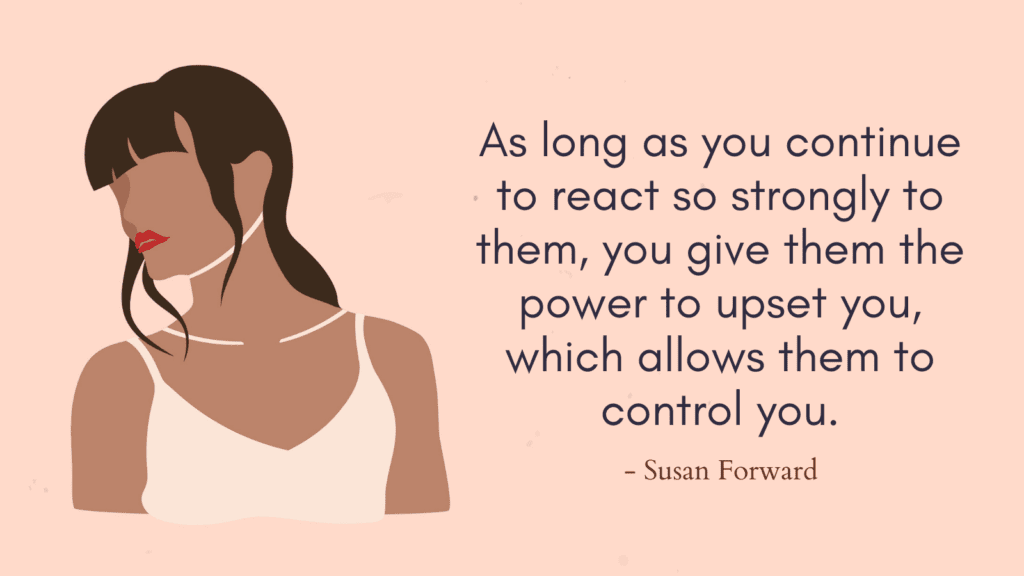This post contains examples of common blame shifting phrases to watch out for.
What is Blame-Shifting?
Blame-shifting is a form of escaping responsibility.
Blame-shift is also often an emotionally abusive tactic the abuser uses to gaslight their victim and bring them down.
Many abusers who use blame-shifting find it difficult to take responsibility for their own behavior or emotions.
They may even blame their victim for their own circumstances.
In most cases, the abuser cannot bear the shame of facing themselves and would rather remain in denial.
Related: 5 Weird Things Covert Narcissists Do To Manipulate Their Victims
Blame-Shifting Phrases
1. “You are too insecure.”
2. “You made me do that.”
3. “I wouldn’t have gotten angry if you wouldn’t nag so much.”
4. “I wouldn’t have lied if you didn’t get upset.”
5. “I wouldn’t have said that if you didn’t provoke me.”
6. “You make me so upset.”
7. “You’re just trying to confuse me.”
Related: Am I Being Gaslighted Quiz (& How To Recover From Gaslighting In 10 Steps)
8. “You should have known how I would react.”
9. “You seem stressed. Not everyone can handle new responsibilities.”
10. “I’m the only one who’s responsible in this relationship.”
11. “This is why you don’t have friends.”
12. “You can’t take a joke.”
13. “The kids know you’re not a good parent.”
Related: Healing From Emotional Abuse In 12 Practical Steps
14. “You’re gaslighting me.”
15. “It’s your fault.”
16. “I don’t know what you want me to say.”
17. “How dare you accuse me of doing that!”
18. “Why are you always bringing up the past?”
19. “I can’t have any negative emotions around you.”
20. “Stop exaggerating.”
21. “There is something seriously wrong with you.”
22. “You’re not perfect, either.”
Related: How To Stop Being Emotionally Abusive? Top 10 Strategies To Break The Cycle Of Abuse
23. “This is how you treat me after everything I’ve done for you?”
24. “You always have to be right.”
25. “Don’t put words into my mouth.”
26. “Your divorce has taken a toll on me.”
27. “Stop trying to mother me.”
28. “Why do you always have to argue with me?”
29. “You read into things too much.”
30. “You always do this.”
Related: Can Abusers Change? Top 17 Myths About Abusive Men That Make Women Stay With Abusers
31. “Why are you like this?”
32. “I never said that! you’re hurting me for even suggesting that!”
33. “Oh, so I guess I can’t say anything anymore.”
34. “Show a little respect.”
35. “You’re so ungrateful.”

How To Deal With Blame Shifting?
Dealing with blame shifting can be challenging, but there are a few strategies you can employ:
1. Stay calm and composed
When faced with blame shifting, it is important to stay calm and composed.
Instead of reacting in anger or frustration, take a deep breath and gather your thoughts.
Remember that getting defensive will only escalate the situation.
For example, if a colleague is blaming you for a missed deadline when it was actually their own procrastination that caused the delay, politely explain the sequence of events without becoming confrontational.
By staying composed, you demonstrate maturity and professionalism, which can help diffuse tense situations.
2. Gather evidence
Blame shifting occurs when someone redirects blame onto others, often as a defense mechanism or to avoid taking responsibility for their actions.
Collecting evidence can help you present a clear and objective account of the situation. This may include documents, emails, or any other tangible proof that supports your innocence.
For example, if a coworker tries to shift blame onto you for a mistake at work, gather any relevant emails or project files that demonstrate your correct involvement or lack thereof.
By presenting factual evidence, you can counter their attempts to shift blame and ensure a fair assessment of the situation.
It is crucial to maintain a level-headed approach throughout this process, offering patience and understanding as you present your case.
3. Communicate clearly and assertively
When faced with blame shifting, it is essential to communicate clearly and assertively in order to address the issue effectively.
Start by clearly expressing your thoughts and feelings about the situation without getting defensive or aggressive.
Use “I” statements to explain how you have observed the blame shifting behavior and how it makes you feel.
For example, you could say, “I have noticed that when a mistake happens, you often shift the blame onto others. This makes me feel frustrated and unheard.”
By using this approach, you are taking ownership of your perspective and avoiding accusing the other person directly.
4. Seek understanding
Dealing with blame shifting requires empathy and a willingness to address the underlying issues at play.
Seek to understand the reasons behind the blame shifting, as there might be underlying issues causing it.
Encourage open communication and try to have a constructive conversation to address the root cause of the problem.
For example, you can say, “I understand you’re frustrated, but let’s focus on finding a solution rather than placing blame. What steps can we take moving forward?”
By actively listening and seeking understanding, you can foster a more positive and collaborative work environment.
5. Offer solutions
One effective way to deal with blame shifting is by offering solutions.
Rather than getting caught up in a cycle of finger-pointing, focus on identifying and addressing the underlying issues.
For example, if a coworker constantly shifts blame onto others for missed deadlines, propose implementing a project management tool or creating clearer communication channels to improve workflow.
By providing practical solutions, you demonstrate a proactive attitude towards problem-solving and encourage others to do the same.
6. Set boundaries
Start by clearly communicating your expectations with the person who engages in blame shifting.
Express that you will not tolerate being blamed for their mistakes or circumstances they create.
Emphasize the importance of taking personal responsibility and encourage open and honest communication.
7. Seek support
Seeking support from friends, family, or a trusted confidant can provide a safe space to express your feelings and gain perspective.
Talking to someone who can offer a neutral viewpoint can help validate your experience and affirm that you are not alone in dealing with this kind of behavior.
They may also provide valuable insights or guidance on how to respond effectively.
Remember that seeking support does not mean seeking revenge or engaging in gossip; instead, it’s about finding understanding, empathy, and advice from those you trust.
In such situations, reaching out for support can empower you to respond assertively, maintain your self-esteem, and work towards resolving the issue.
Remember, patience is key when dealing with blame shifting. Stay true to yourself, focus on facts, and strive for open communication.
Conclusion
Blame-shifting is a form of crazy making and twisting facts.
The abuser not only seeks to escape responsibility but also to shift the focus on you, get you off balance, and maintain all the power and control over the victim and their relationship.



